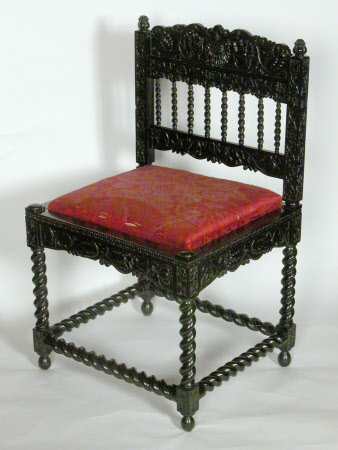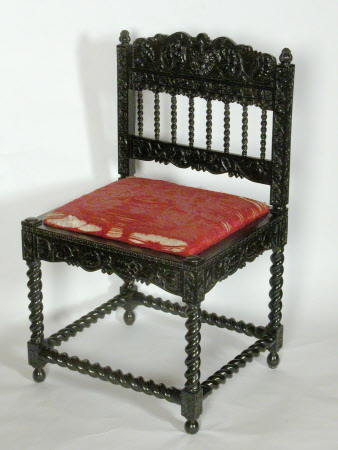Chair
Category
Furniture
Date
circa 1680 - 1700
Materials
Ebony, turned and carved, silk damask
Place of origin
Coromandel Coast
Order this imageCollection
Charlecote Park, Warwickshire
NT 533024
Summary
A pair of East Indian carved ebony chairs, made in the Coromandel Coast, circa 1680-1700, each with a top rail carved with vines of leaves and berries, above twist-turned spindles, the side rails surmounted by buds finials, the square drop-in seat above similarly carved seat rails, on twist-turned legs joined by stretchers. An almost identical chair can be seen at the Victoria and Albert Museum (inv. 413-1882). It belonged to Alexander Hamilton, 10th Duke of Hamilton (1767-1852), possibly inherited from his father-in-law, the collector William Beckford (1760-1844). The mid-seventeenth century ebony furniture produced in the Coromandel coast of India was very fashionable in the early years of the nineteenth century, especially sets of carved ebony chairs. In the 1750s Horace Walpole (1717-1797) acquired many pieces of such carved furniture for his Gothic house of Strawberry Hill. He believed they were surviving examples of early English furniture based on their existence in houses with Tudor associations, notably Esher Place, Surrey, where he believed them to have been the property of Cardinal Wolsey. William Beckford also had several examples of carved ebony chairs and cabinets at Fonthill Abbey, described in the sale catalogue as "Wolsey chairs" (1823). At Charlecote a few specimen can still be found ( NT 533025; NT 533026) including a sofa (NT 533023).
Provenance
Presented to the National Trust by Sir Montgomerie Fairfax-Lucy (1896 – 1965), two years after the death of his father, Sir Henry Ramsay-Fairfax, 3rd Bt (1870 – 1944), with Charlecote Park and its chief contents, in 1946.
References
Jaffer 2001 : Amin Jaffer, Furniture from British India and Ceylon, a catalogue of the collection in the Victoria and Albert Museum and the Peabody Essex Museum, London, V&A publications, 2001.

